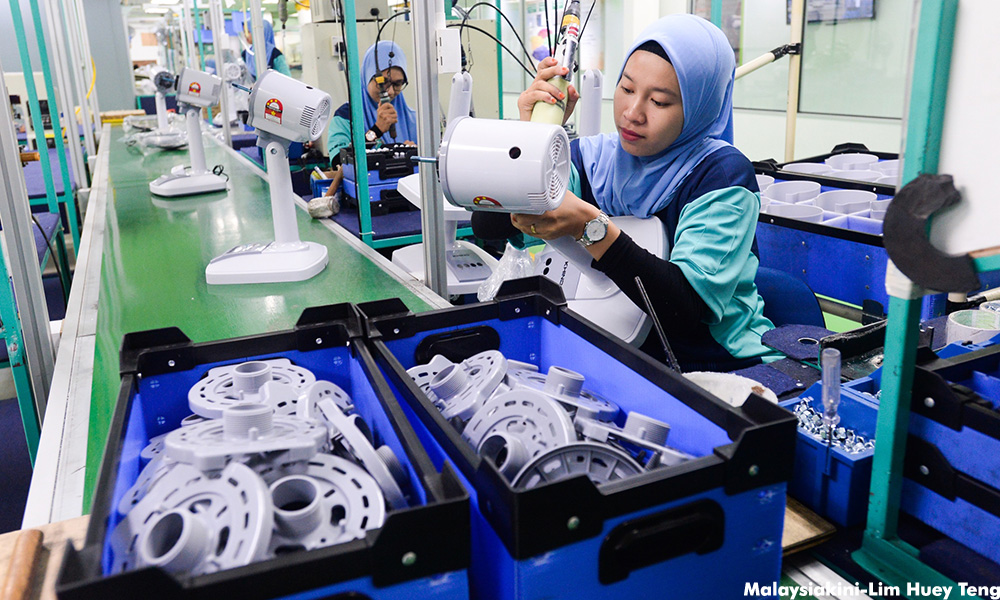LETTER | Recently, I shared a story about a young Malaysian who came from a poor background, did well in his SPM, obtained a state scholarship to study Economics at a prestigious UK University, only to struggle to find the right job here in Malaysia upon graduation. He decided to pursue a Masters at a local university whilst waiting for the right offer. Only after completion of his Masters did he finally land a job as a contract analyst for a financial firm. His starting salary? RM 1,800.
Little did I expect the response to this tale from fellow Malaysians as it was shared in the thousands on social media and got hundreds of reactions. Many shared their own stories of highly-qualified graduates struggling to find jobs and of low starting salary. There are also those who reminisce how they started with low pay but are now doing well and that youths today are a bunch of whiners — the usual doom and gloom versus “we had a tougher time” dichotomy that pervades today’s hyper-reactionary social media debate.
But beyond the rhetoric and anecdotes, what’s the economic reality for Malaysian youths? For that, we will look at three areas of concern - wages for entry-level positions, job creation for youths and finally, cost of living.
Stagnant wages are not a myth
There are plenty of anecdotal stories of how starting salaries for graduates have been the same since the mid-2000s and the statistics lend credence to this narrative. According to Bank Negara’s Economic Development in 2018 report, starting salaries (after adjustment for inflation) has declined for those with tertiary education between the period of 2010 to 2018. A fresh graduate with a diploma earned a real salary of only RM1,376 in 2018 (2010: RM1,458) while a Masters degree holder earned a real salary of RM2,707, a significant decline from RM2,923 in 2010.
Interestingly, the reverse is true for those without tertiary education. School leavers with only PMR, SPM, STPM or Certificate level qualifications have seen their starting salaries rise between 1.1 percent to 4.6 percent. In fact, it appears that there is an inverse relationship between qualification and growth in starting wages with the least qualified (PMR level) experiencing the highest growth rate and the most qualified (Masters degree) experiencing the highest decline.
We often hear people citing the huge pay packages for mid- and senior-level management, in particular CEOs and directors, of Malaysian companies including government-linked institutions as contrary evidence of stagnating wage growth.
For example, in 2005, the executive director of a government-linked telco giant was paid close to RM 1 million in salaries and bonuses. By the end of 2016, the same role has seen total pay-out worth RM 5.8 million, with salary increasing to RM 2.3 million for the year despite absolute revenue - before even adjusting for inflation - being higher in 2005. Whilst this wage growth for top executives is in line with global trends and by itself should not be a cause of concern, the problem lies in the unequal distribution in growth especially for fresh graduates and those in non-executive roles.

According to World Bank’s 2019 Malaysia Economic Monitor report, which looks at data from 2004 to 2016, the median monthly income for those between 20 to 29-years-old with post-secondary education has remained flat at between RM 2,000 - RM 2,500. Meanwhile, those between 40-49 and 50-59-years-old range experience the biggest growth in median wages moving from around RM 5,000 to more than RM 6,000 within the same 12 years. This supports the earlier narrative that wage growth has been stagnant for the youths throughout the years despite Malaysia experiencing an average of 7.0 percent GDP growth annually.
Young Malaysians, especially graduates, are suffering from a decline in starting salaries whilst their wage growth has been stagnant since the mid-2000s. There are many factors to this, but I would like to focus on what I feel is the biggest contributor - the state of Malaysia’s job market.
Focus on underemployment, not unemployment
We often hear of “youth unemployment” with many news reports citing the 2018’s 10.9 percent youth unemployment rate in Malaysia as being a major cause of concern. This is alarmist in isolation, especially when reporters use phrases like “youth unemployment is three times higher than the national unemployment rate”. The facts are simple - our labour participation rate is growing, we are technically fully employed by OECD’s (the Organisation for Economic Co-operation and Development) definition, the 10.9 percent youth unemployment rate is below the global average and comparable to other growing economies.
Without context, this figure is meaningless. For example, the youth unemployment rate for Rwanda is 1.64 percent and for Australia it is 12.9 percent, but do we prefer Rwanda’s state of economy or Australia’s? Japan has a low youth unemployment rate at around 5 percent, but they are also an ageing nation. Sweden’s youth unemployment rate? 17.4 percent. Context is everything.
Our youths are facing a more serious problem - underemployment. Underemployment is where youths are employed in roles where they are not working full-time or having regular jobs such as freelancing or where they are overqualified for the role. You have heard of engineering graduates working as food-delivery riders, or health sciences graduates working as clerical staff. Sure, a job is a job and beggars can’t be choosers but do we have to accept that our youths have to beg for a job in the first place? Let’s look at the numbers.

According to Bank Negara, between 2010 and 2017, the number of tertiary graduates entering the workforce surpassed the number of jobs created for them. In its annual report published in 2019, it said that on average, 173,457 diploma and degree graduates entered the workforce annually over that period. But only 98,514 high-skilled jobs were created over that time. Between 2002–2010, 8.0 percent of the net change in new jobs created are for low-skilled work but between 2011–2019, this figure has risen to 16 percent - a 100 percent increase.
In short, this economy has created more low-skilled work than high-skilled work since the financial crisis of 2008/09, whilst the number of graduates continues to remain constant. This has resulted in graduates unable to be employed appropriate to their skill or qualification level. As of 2016, 667,000 graduates are working in low or medium-skilled jobs. This is 20.7 percent out of the total 3 million-plus graduates participating in the labour market - the highest level since 2001.
When there aren’t enough high-skilled jobs created, skilled workers, including fresh graduates, will take on any job thus putting downward pressure on wages as medium and low-skilled jobs pay on average less than high-skilled ones. Not only that, they limit the opportunities for those without qualifications as roles fit for high-school leavers are now being filled with college graduates.
Data shows that teenagers (ages 15–19) have far higher unemployment rates than young adults (20–24), even though they all contribute to the youth unemployment numbers. Teenagers are 1.7 times and almost five times more likely to be unemployed compared to young adults and the overall labour workforce respectively.
The reality concerning expenses
Overall, Malaysia’s labour market has created insufficient medium- and high-skilled jobs for the number of graduates which has resulted in stagnating wages especially for the youths and those occupying lower-income jobs. Surely, this is unsustainable, what with our rising cost of living.
But herein lies a more nuanced truth, that whilst “rising cost of living” has been bandied about by leaders, politicians and news outlets, the reality is that Malaysia’s core and headline inflation has been fairly stable over the years. In fact, studies have shown that there is a huge gap between the perceived inflation rate and the actual inflation rate. This is not helped by the fear-mongering in public discussions.
But at the same time, this does not mean that Malaysians are earning “enough”. In 2018, Bank Negara presented a paper putting forth the idea of a “living wage” in Kuala Lumpur. Based on their assumption, a single adult needs to earn RM 2,700 per month to be able to have meaningful participation in Kuala Lumpur.

According to the same report, starting salaries for those with degrees are on average only RM 2,207. A big component of living expenses is on accommodation. Everyone agrees, and Khazanah Research supports this, that housing prices in Malaysia, especially in major cities, are at a severely unaffordable level.
What is more worrying, and related to wage stagnation, is the prospect of intergenerational social mobility for the current generation. Intergenerational social mobility means the ability of the present generation to live a “better life” - measured by income and education attainment - compared to the previous generation.
Based on Khazanah Research Institute’s 2019 paper on this matter, those who were born to lower-income parents experienced upward mobility in education and income whilst those who were born to higher-income parents did not experience the same. If this trend continues, the generation born in the 2000s will find it harder to earn more and live a “better life” than their parents.
It's all about jobs, jobs and more jobs
Discussion on youth unemployment, stagnating wages and related often veer towards solutions focusing on improving the youths themselves. Skills mismatch, Tvet (Technical and Vocational Education and Training), increasing higher-order thinking skills, revamping education system - these are all focusing on improving the “supply” side of the labour market.
Whilst there are merits to these ideas, the simple fact remains that our economy has not created enough jobs, in the right sector, at the right pay, in the past 12 years that could absorb the number of supply coming through, no matter how much improvement we make to their quality. The reason why policy discussions often veer to the supply side is that it is relatively easier to “correct” the youths as opposed to solving the harder problem of job creation.
I put forward that we focus on ideas to:
- Create more jobs for Malaysians
- Increase the growth of high-skilled jobs
- Increase the income level for these jobs
We could start by revisiting our policies on foreign labour. According to Bank Negara’s 2018 report, in 2015 and 2016, a large share of net jobs created went to foreigners. Our documented migrant to population ratio at 8 percent is also higher than other regional peers (with the exception of small states like Singapore and Brunei). This loose policy on cheap foreign labour has resulted in the reliance on manpower over automation, which reduces overall productivity per worker and prevents the introduction of higher-paying jobs, especially for our graduates from Stem (Science, Technology, Engineering and Mathematics) fields.
Related to this, but more controversial, is the proposal for government-linked institutional investors to put shareholders’ pressure on invested companies to give preference to local talent in senior management roles. The above measures may not increase the overall jobs created or the quality, but it will increase the availability of such roles for Malaysians.
To significantly increase the number of jobs created, our economy must shift from its current economic mix and undergo the same massive transformation we experienced in the 80s as we moved from agriculture base to manufacturing. As with any massive economic transformation programme, the government plays a critical role.
The previous administration’s focus on the strength in domestic consumption and services sector may help to increase overall GDP, but it is my belief that to truly catapult us into a high-income nation, Malaysia’s primary GDP growth must come from exports and increasing the flow of foreign capital into the country.
There are many industries which I believe can be exportable, creates massive highly-skilled employment, and where we have some inherent strategic advantage that cannot be easily replicated. For example, our climate and location make us the prime candidate to benefit from the battle for global food security. The recent calls from the government and prominent figures like former finance minister Daim Zainuddin for Malaysians to venture into agriculture appear timely.
Another industry that stands to benefit from our natural advantage is renewable energy. The government should embark on a massive renewable energy initiative through direct rebate and tax incentives for local households and businesses to shift towards solar energy, which in turn would further drive down the cost of solar panels produced in Malaysia.

Fun fact - as of 2016, Malaysia is already the largest exporter of solar cells and modules to the United States. We should endeavour to make Malaysia one of the top nations in terms of energy security, energy cost and sustainability to attract energy-intensive industries to shift here such as data centres.
Other sectors at the top of my head which can be further encouraged to exploit our existing advantages include tourism (specifically edu-tourism and events), halal products and certification, electronic and electrical manufacturing in remote devices, and automotive manufacturing for electric vehicles.
As for increasing wages, I find it perplexing that a lot of the discussion focuses on the high income of senior management and on closing the gap by putting caps on high wages. Whilst it may make good optics and be popular for a short while, in the long term, making some people earn less will not help the vast majority who are low-income earners to meet their living needs. The key has always been to create a growing demand for skilled workers that are higher than the supply of them to stimulate wage growth across the board.
At the same time, I strongly believe that companies that operate based on government-sanctioned monopolies - such as power, transport, telecommunications, and financial service - which means they have virtually zero competition and enjoy above-average margins should take the lead in both capping pay for senior management and increasing drastically the overall median pay of their lower-income group. This will create competition for talent, especially young graduates and force other companies to offer similarly attractive packages.
Structural changes to the economy will take some time, and the effects on our youths will be felt in perhaps the following generation. But change we must. By focusing on creating more jobs for Malaysians, in industries of higher value, we will improve the economic conditions for our youths.
I know that many are sceptical of the recently announced Shared Prosperity Vision 2030, but at its core, it tries to address the issue of inclusiveness in economic growth and that includes improving the wages, living standards and economic reality for youths. As always, the devil is in the details and as Steve Jobs once (allegedly) said: “Ideas are worth nothing unless executed. They are just a multiplier. Execution is worth millions.”
For the sake of our present and future youths, we must get the execution right this time.
The views expressed here are those of the author/contributor and do not necessarily represent the views of Malaysiakini.

